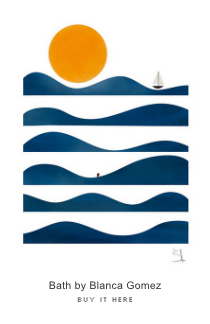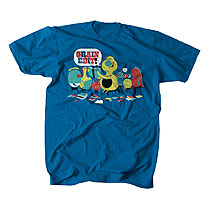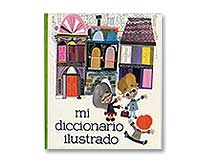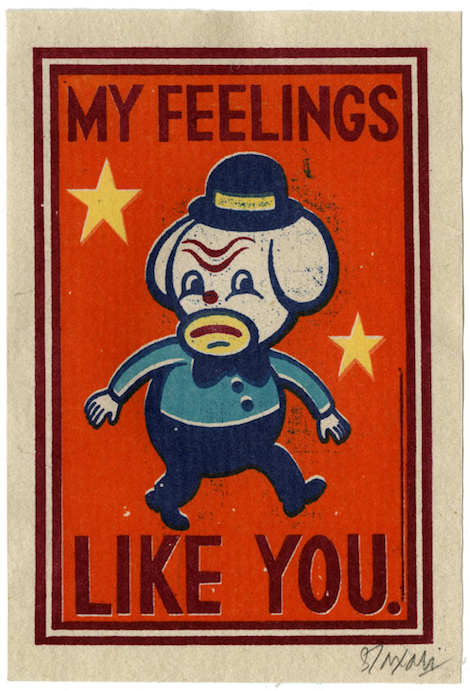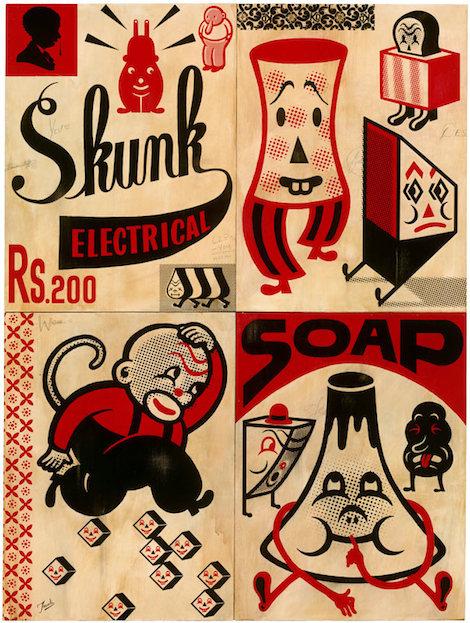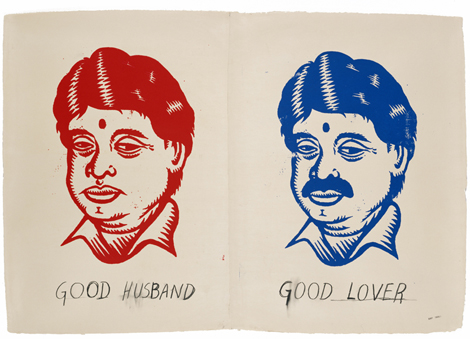Gary Taxali Interview
Today’s Grain Edit interview is brought to you by guest contributor Deva Mirel, and features the words and works of illustrator/fine artist Gary Taxali. We catch up with Gary after he returned in early May from his first solo show abroad at The Outsiders in London. Gary lives and works in Toronto but is originally from India. Here he discusses his most recent show, locating the desi in his work, why kids love him, and some straightforward tips on being in the business of making art.
First off, thanks so much for taking time for this interview. I know it’s been an extremely busy few weeks for you. Your work was shown in California in the show “New Blood,” curated by Morgan Spurlock. The aim of that show was to highlight the game changers of the art world with an eye on the future. Every big name artist brought on board a protégé’ to exhibit alongside them. At the same time, you had your first UK solo show–“My Feelings Like You”–at The Outsiders in London. What challenges did you face having 2 shows opening at once?
The only challenge was that the openings were so close in date so it was impossible for me to attend both. Naturally I picked my solo show. I loved Morgan’s concept for the show and it was really great that Thinkspace Gallery got behind it.
How has your work evolved from your last major solo show–“Hindi Love Song”–in New York?
I don’t know if it’s evolved in a tangible way but perhaps what’s more concise is the messaging in my latest show. That is, I think there are themes I explored that are more cohesive from piece to piece. For example, In “My Feelings Like You”, I really wanted to show more narrative pieces. In a recent interview I did for Lust and Found, I wrote:
“The themes explored are just as much about introspection as well as searching. There are a lot of assertions in the works I make about states of being and status of place. Yet there are also inquisitive, questioning and curious follies regarding various emotions and relationship dynamics. These are realized through my constant exploration of angst, happiness and catharsis that I hope is evident in the characters I draw and paint. A common character I am known for, The Toy Monkey, makes a few appearances in these new works. He’s a guide, if you will. Many people may surmise that he’s taking the viewer to a past time, in particular the 1920s or 1930s, but I’d like think that the place is just a byproduct and the real journey is in conveying the emotions through narratives.”
Practically everything I’ve read about your show at The Outsiders notes the debut of your largest work to date. Skunk Electrical Soap measures in at 152 X 203 cm. When I googled the conversion to inches (60″ x 80″), I learned that those are the measurements of a queen size mattress. That’s big! Now your other work is mixed media, often painted or silk screened onto found or repurposed materials that already include some scribble, stain, or marking that inspires you. Are the larger pieces in this collection born of blank canvas?
Skunk Electrical Soap is my largest work to date. Large works, due to the logistical nature of their size, have to b planned out to be realized in the way I envision, otherwise there is too much loss of control that may pose disastrous results. That said, I still employed my usual spontaneous methods of painting, draw characters and words, and so on.
In other interviews you’ve stated that you’ve never suffered a creative block and that you are always drawing. Can you take us through the actual process of how you take a piece from a doodle and develop it into a work of mixed media fine art?
For the most part, I work on several pieces at once. I’ll often draw a character that stems out of multiple sketches. From there, I may screen print on a random surface. I may even begin from scratch and draw directly on the paper. Sometimes, I’ll plot out a few characters and text and do larger screen prints on various paper surfaces that I experiment with. I also do straight painting (as is in this show) that employs more traditional methods. As for creative blocks, I never have time to ruminate endlessly over pictures. I always have some kind of deadline for shows and projects so I have to dive in head first and just make stuff!
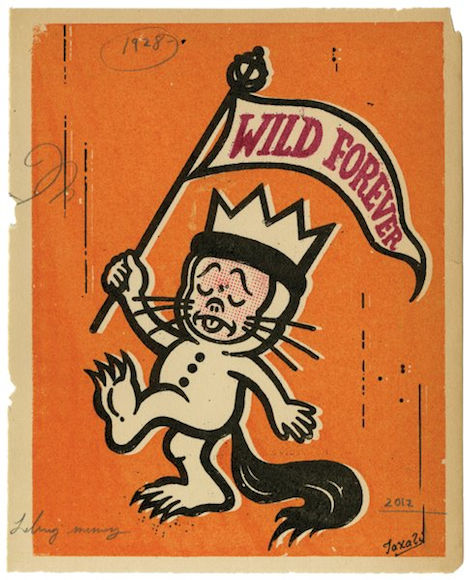
Gary Taxali tribute to Maurice Sendak for the New York Times
Do you have any rituals, routines, habits, or superstitions unique to you that are part of your creative process?
No, but I probably should. The only habit I have, which is not unusual or interesting, is that I cannot work without listening to music. That is vital for my working process.
I was looking at pictures from your 2009 show at Jonathan LeVine Gallery in New York and also at the photos you posted on Facebook from your recent show in London and there seems to be a reoccurring theme: the presence of absolutely adorable kids at your show. How fun is it for you to be able to create and exhibit works that appeal to the junior art set?
That’s a great observation and something I haven’t really thought in depth about. I get a lot of nice response from children and I love having them at my shows. At my “Hindi Love Song” show at the Jonathan LeVine Gallery, my friend and amazing artist, Stephen Kroninger, came with his wife and 2 lovely young twin daughters, Hanna and Rachel. Hanna and Rachel were walking around the opening, sketching various works. I thought that was fantastic! At my show last week in London, a beautiful little blonde haired girl named Nancy presented me with a signed drawing she made. She must have been about 3 or 4. She was absolutely adorable!
“Hindi Love Song” elicited a lot of chatter about your roots in India and the influence of Indian culture on your work, for obvious reasons. “My Feelings Like You” conjures the same cast of characters, but the name of the show seems to work with a universal immediacy that neuters the reading of these pieces as mindfully Indian. Do you agree?
I do agree. For a while now, I’ve been planning a series (possibly a show) of portraits of non-existent Bollywood stars. “Fake” portraits, if you will. I had one in my “Hindi Love Song” show and have also done this in the past but since it’s something I wanted to revisit in a more in depth way, I suppose I may have consciously chose to set aside specific Indian themes for that reason. Next time, for sure!
Aside from attending your opening, what else did you do while in London?
I saw some terrific shows while I was in London. I was lucky enough to have my show coincide with Damien Hirst’s retrospective at the Tate Modern. I also saw a terrific show at the Cartoon Museum by a deceased British Illustrator named H.M. Bateman. His work is incredible. David Shrigley also had an exhibition at the Hayward Gallery, which was a spectacular show of his amazing works. I met some local artists including the brilliant Simon Spilsbury and Paul Davis. And finally, I ate the best Indian food! Vandana, myself and friends (on Vandana’s suggestion) went to Moti Mahal in Covent Garden. For a great Indian culinary experience, I recommend this restaurant! The vegetarian tasting menu is heavenly.
One word I associate with your style is playful. At the same time, you seem quite astute as a business man. I know your sister Vandana is your agent and together you rival the Wonder Twins with your super powers. Any advice, on the business side of things, you can offer to up and comers who don’t have a Vandana in their family tree?
My advice is for emerging artists is to never devalue your work. It’s easy to get excited about doing fun projects and seeing your work in print but one must never forget that someone is making money off your work and you should be compensated accordingly. I’m not talking about pro bono work for charities and other non-profit organizations with great causes; I’m referring to commercial enterprises that sometimes take advantage of artists by offering low fees and unfair contractual terms. My advice is to purchase Tad Crawford’s “Business and Legal Forms for Illustrators”. My other piece of advice is for young artists to build a social network of other artists and to really nurture those connections. It’s easy to work in a vacuum but the fact is, we need each other. So many great business tips as well as emotional support can come from fellow artists who share the same challenges and frustrations.
A few months back, the Royal Canadian Mint released 6 coins of your design, making Canada the country with the coolest currency in circulation. You’ve had your characters made into toys, put out a children’s book, and have also been nominated for a Grammy for your cover art on Aimee Mann’s album. What’s next?
The Royal Canadian Mint released 5 coins in January. Each of the 5 had a theme of “Birthday”, “New Baby”, “Wedding”, “O Canada” and “Tooth Fairy”. In the fall, the Mint will be releasing the 6th coin, “Holiday”. Other than that new coin coming out, I will be working on a number of group shows. I’m also doing some writing now for some new children’s book ideas that I’m pretty excited about. Lastly, I need a vacation! I’d like to visit Canada’s east coast like Cape Breton as I haven’t been and it looks lovely.
You’ve noted in previous interviews that the characters you create are, to some extent, a mirror of yourself. So I have to ask, are you the head with or without the mustache?
Both, depending on the hour of the day!
*Lead Photo of Gary Taxali by Ian Cox
We would like to extend a great big thank you to Gary for sharing his work with Grain Edit. Please be sure to visit his website to see more work. Also, don’t forget to stop by the shop to pick up his latest books and accessories.
Select books including Mono Taxali, I Love you, Ok? and This is Silly! are available at Amazon.
——————–
Also worth checking:
Sanjay Patel Interview
Tad Carpenter Interview
Hans Hartmann
Not signed up for the Grain Edit RSS Feed yet? Give it a try. Its free and yummy.
——————–
TagsCanada, Illustration, Interviews



















